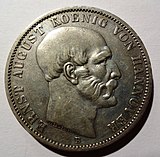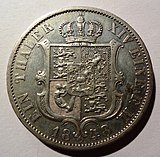Fear thaler
Fear Taler were in contemporary vernacular and are still in the numismatics two in the Kingdom of Hanover and the Grand Duchy of Mecklenburg-Schwerin in the revolutionary year of 1848 embossed Taler called, which in transliteration of the crest side of the additional VGG missing ( "Grace of God").
Background and development in the Kingdom of Hanover
In March 1848 political unrest broke out in many countries in Germany and in other European countries, which were connected with the demand for more democracy and constitutionally guaranteed civil rights. The ruler of the Kingdom of Hanover, Ernst August I (reigned 1837 to 1851), was considered to be particularly conservative. His predecessor Wilhelm IV (reigned 1830 to 1837) had already added the addition VGG for “by God's grace” to the larger denominations of his coins after his name . This addition should underline the claim that the right to rule can be traced back directly to God's will. He was in opposition to the idea of popular sovereignty .
In most cases, Ernst August continued to add the addition VGG after his name to the portrait page for his higher denominations . The usual inscription of the denominations from sixth thaler to ten thaler gold coin read: ERNST AUGUST VGG KOENIG V. HANNOVER . A taler minted in the years 1848 and 1849 (AKS No. 107) varied this inscription in: ERNST AUGUST KOENIG VON HANNOVER . The omission of the addition VGG was and is understood as a concession to the insurgents. This interpretation is supported by the fact that Ernst August appointed a leader of the opposition at the time, Stüve, as Minister of the Interior. The postulate of divine right was one of the main points of criticism of the democratic movement , so that it seems understandable that Ernst August wanted to avoid political explosives by dispensing with this addition, which did not mean an immediate loss of power. The renunciation was interpreted not only as consideration or political prudence, but also as the prince's fear of the democratic movement.
However, the use of the addition VGG was not a dogma even before 1848. So was z. B. in the years 1845 and 1846 a five-taler gold coin (AKS No. 93) minted without this addition. The omission of the addition was not mandatory because of the smaller diameter of the gold coins for reasons of space, since the smaller two and a half thaler gold coins in these years (AKS No. 97) had the VGG addition.
Development in Saxony and Mecklenburg-Schwerin
In the Kingdom of Saxony , before the revolution in 1848, as well as in this year and in the years after, the addition VGG was used in the transcriptions on the coins. It is believed that due to the popularity of the Saxon royal family at that time, there were no concerns about this addition.
The development in the Grand Duchy of Mecklenburg-Schwerin was different . The thaler first minted in 1848 during the reign of Friedrich Franz II in Mecklenburg-Schwerin in the fourteen-thaler foot (see coin footer ) (previously guilders with a value of two-thirds thalers had been minted) did not contain the addition VGG . This coinage is also known as the "fear thaler" (AKS No. 37). The first subsequent thalers minted in 1864 (no thalers had been minted in between) now bore the VGG addition.
literature
- Rainer Albert: Fresh up, my people, with a drum beat - The revolutionary year of 1848 in German coinage . In: Political Ideas on Coins, Series of the Numismatic Society Speyer, Volume 31, Speyer 1991
- Arnold / Küthmann / Steinhilber (AKS): Large German coin catalog from 1800 to today . Battenberg Verlag, various editions, Munich
Individual evidence
- ↑ Rainer Albert: Fresh up, my people, with a drum beat - the revolutionary year 1848 in German coinage . In: Political Ideas on Coins, Series of the Numismatic Society Speyer, Volume 31, Speyer 1991, p. 110.
- ↑ Rainer Albert: Fresh up, my people, with a drum beat - the revolutionary year 1848 in German coinage . In: Political ideas on coins, series of publications of the Numismatic Society Speyer, Volume 31, Speyer 1991, p. 112 f.



